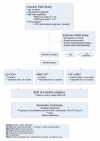The INeS study: prevention of multiple pregnancies: a randomised controlled trial comparing IUI COH versus IVF e SET versus MNC IVF in couples with unexplained or mild male subfertility
- PMID: 20021654
- PMCID: PMC2804565
- DOI: 10.1186/1472-6874-9-35
The INeS study: prevention of multiple pregnancies: a randomised controlled trial comparing IUI COH versus IVF e SET versus MNC IVF in couples with unexplained or mild male subfertility
Abstract
Background: Multiple pregnancies are high risk pregnancies with higher chances of maternal and neonatal mortality and morbidity. In the past decades the number of multiple pregnancies has increased. This trend is partly due to the fact that women start family planning at an increased age, but also due to the increased use of ART.Couples with unexplained or mild male subfertility generally receive intrauterine insemination IUI with controlled hormonal stimulation (IUI COH). The cumulative pregnancy rate is 40%, with a 10% multiple pregnancy rate.This study aims to reveal whether alternative treatments such as IVF elective Single Embryo Transfer (IVF e SET) or Modified Natural Cycle IVF (MNC IVF) can reduce the number of multiple pregnancy rates, but uphold similar pregnancy rates as IUI COH in couples with mild male or unexplained subfertility. Secondly, the aim is to perform a cost effective analyses and assess treatment preference of these couples.
Methods/design: We plan a multicentre randomised controlled clinical trial in the Netherlands comparing six cycles of intra-uterine insemination with controlled ovarian hyperstimulation or six cycles of Modified Natural Cycle (MNC) IVF or three cycles with IVF-elective Single Embryo Transfer (eSET) plus cryo-cycles within a time frame of 12 months.Couples with unexplained subfertility or mild male subfertility and a poor prognosis for treatment independent pregnancy will be included. Women with anovulatory cycles, severe endometriosis, double sided tubal pathology or serious endocrine illness will be excluded.Our primary outcome is the birth of a healthy singleton. Secondary outcomes are multiple pregnancy, treatment costs, and patient experiences in each treatment arm. The analysis will be performed according tot the intention to treat principle. We will test for non-inferiority of the three arms with respect to live birth. As we accept a 12.5% loss in pregnancy rate in one of the two IVF arms to prevent multiple pregnancies, we need 200 couples per arm (600 couples in total).
Discussion: Determining the safest and most cost-effective treatment will ensure optimal chances of pregnancy for subfertile couples with substantially diminished perinatal and maternal complications. Should patients find the most cost-effective treatment acceptable or even preferable, this could imply the need for a world wide shift in the primary treatment.
Trial registration: Current Controlled Trials ISRCTN 52843371.
Similar articles
-
Is IVF-served two different ways-more cost-effective than IUI with controlled ovarian hyperstimulation?Hum Reprod. 2015 Oct;30(10):2331-9. doi: 10.1093/humrep/dev193. Epub 2015 Aug 12. Hum Reprod. 2015. PMID: 26269539 Clinical Trial.
-
IVF with planned single-embryo transfer versus IUI with ovarian stimulation in couples with unexplained subfertility: an economic analysis.Reprod Biomed Online. 2014 Mar;28(3):336-42. doi: 10.1016/j.rbmo.2013.10.021. Epub 2013 Dec 1. Reprod Biomed Online. 2014. PMID: 24456703 Clinical Trial.
-
Birthweight and other perinatal outcomes of singletons conceived after assisted reproduction compared to natural conceived singletons in couples with unexplained subfertility: follow-up of two randomized clinical trials.Hum Reprod. 2021 Feb 18;36(3):817-825. doi: 10.1093/humrep/deaa298. Hum Reprod. 2021. PMID: 33347597 Free PMC article.
-
Intra-uterine insemination for unexplained subfertility.Cochrane Database Syst Rev. 2020 Mar 3;3(3):CD001838. doi: 10.1002/14651858.CD001838.pub6. Cochrane Database Syst Rev. 2020. PMID: 32124980 Free PMC article.
-
[In vitro fertilization versus conversion to intrauterine insemination in patients with poor response to controlled ovarian hyperstimulation].Gynecol Obstet Fertil Senol. 2018 Feb;46(2):118-123. doi: 10.1016/j.gofs.2017.11.001. Epub 2018 Jan 17. Gynecol Obstet Fertil Senol. 2018. PMID: 29373313 Review. French.
Cited by
-
The multiple birth epidemic: revisited.J Obstet Gynaecol India. 2012 Aug;62(4):386-90. doi: 10.1007/s13224-012-0309-7. J Obstet Gynaecol India. 2012. PMID: 23904695 Free PMC article.
-
Prevention of multiple pregnancies in couples with unexplained or mild male subfertility: randomised controlled trial of in vitro fertilisation with single embryo transfer or in vitro fertilisation in modified natural cycle compared with intrauterine insemination with controlled ovarian hyperstimulation.BMJ. 2015 Jan 9;350:g7771. doi: 10.1136/bmj.g7771. BMJ. 2015. PMID: 25576320 Free PMC article. Clinical Trial.
-
Natural cycle in vitro fertilisation (IVF) for subfertile couples.Cochrane Database Syst Rev. 2013 Aug 30;2013(8):CD010550. doi: 10.1002/14651858.CD010550.pub2. Cochrane Database Syst Rev. 2013. PMID: 23990351 Free PMC article.
-
Interventions for unexplained infertility: a systematic review and network meta-analysis.Cochrane Database Syst Rev. 2019 Sep 5;9(9):CD012692. doi: 10.1002/14651858.CD012692.pub2. Cochrane Database Syst Rev. 2019. PMID: 31486548 Free PMC article.
-
Choosing and changing the analysis scale in non-inferiority trials with a binary outcome.Clin Trials. 2022 Feb;19(1):14-21. doi: 10.1177/17407745211053790. Epub 2021 Oct 24. Clin Trials. 2022. PMID: 34693789 Free PMC article.
References
Publication types
MeSH terms
Substances
Associated data
LinkOut - more resources
Full Text Sources
Medical
Research Materials
Miscellaneous


